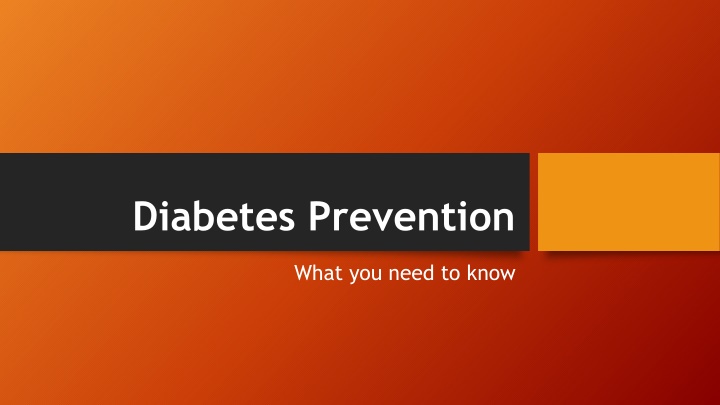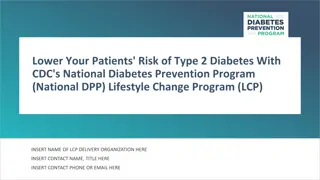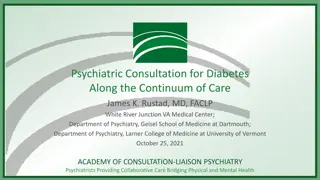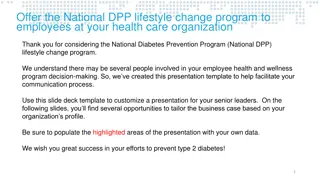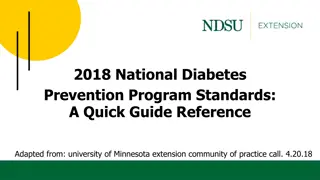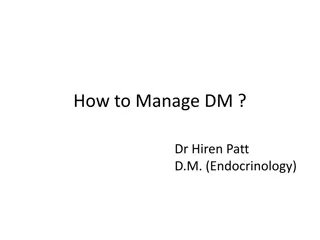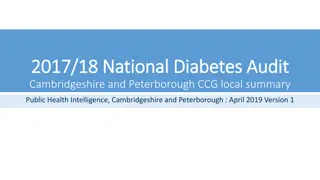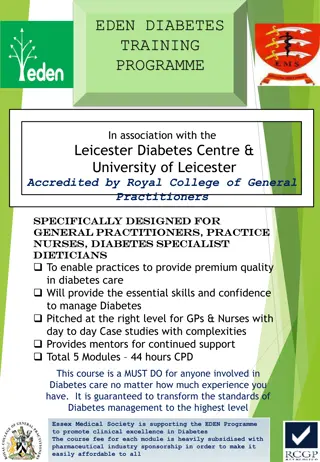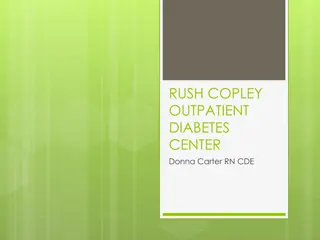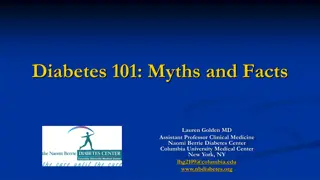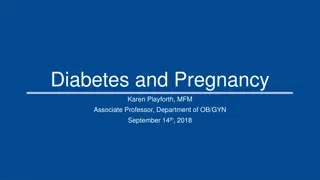Diabetes Prevention
Learn about the essential facts on preventing diabetes to protect your health. Discover effective strategies, lifestyle changes, and key information for early detection. Empower yourself with the knowledge to lower your risk of developing diabetes and live a healthier life.
Uploaded on Mar 06, 2025 | 2 Views
Download Presentation

Please find below an Image/Link to download the presentation.
The content on the website is provided AS IS for your information and personal use only. It may not be sold, licensed, or shared on other websites without obtaining consent from the author.If you encounter any issues during the download, it is possible that the publisher has removed the file from their server.
You are allowed to download the files provided on this website for personal or commercial use, subject to the condition that they are used lawfully. All files are the property of their respective owners.
The content on the website is provided AS IS for your information and personal use only. It may not be sold, licensed, or shared on other websites without obtaining consent from the author.
E N D
Presentation Transcript
Diabetes Prevention What you need to know
Why are we talking about Diabetes? In the USA over 38.4 million adults over the age of 18 have diabetes (14.7%). The percent of people who have diabetes in Nebraska and in the USA as a whole has been on the rise since 2000.
The types of Diabetes. There are three main types of Diabetes, we are focusing on GDM Your doctor can diagnose diabetes or GDM using blood tests. The blood tests show if your blood glucose (sugar) level is higher than the range that is healthy for you. Blood tests can also help identify the type of diabetes you have. Type 1 Diabetes: Cannot be prevented and makes up 5% of cases of diabetes in adults. More common to be diagnosed among children. Type 2 Diabetes: Onset is more gradual and makes up 90-95% of cases of diabetes in adults. It can be prevented. Gestational Diabetes (GDM): Develops during pregnancy and can lead to complications if not managed. Women who develop GDM during pregnancy have significant risk for developing type 2 diabetes later in life.
What is Gestational Diabetes? Gestational diabetes mellitus (GDM) means you have high blood glucose levels (blood sugar), but those levels were normal before you were pregnant. Women with GDM usually have no symptoms and learn about having GDM from a routine pregnancy screening test. If you have GDM you can still have a healthy baby with help from your doctor and by making healthy choices. GDM will most likely go away after your baby is born. If you have GDM you and your baby will have a higher risk of developing type 2 diabetes.
Gestational Diabetes (GDM) 5% to 9% of US pregnancies are affected by gestational diabetes Risk Factors Include: Overweight before pregnancy Rapid weight gain during pregnancy A family member with type 2 diabetes Had GDM in another pregnancy You are over age 25 Gave birth to a baby who weight 9+ pounds Had a baby that was stillborn Have polycystic ovary syndrome (PCOS) This Photo by Unknown Author is licensed under CC BY-NC-ND
What is the Prediabetes Risk Test? 7 Questions that take about 1 minute If you score more than 5 you are at increased risk for having prediabetes. Only your provider can tell for sure if you have type 2 diabetes or prediabetes. Talk to your health care provider to see if additional testing is needed.
Start now with 8 Healthy Choices Start your day with fiber here are some choices Whole grain cereals Use berries, dried fruit, or nuts to add sweetness to your cereal. Whole grain bread with peanut butter or avocado Eggs or egg substitute with cut up vegetables adds some protein Grapefruit, oranges, plums, kiwi, or cherries This Photo by Unknown Author is licensed under CC BY
Start now with 8 Healthy Choices Add color to your lunch and dinner plate every day! Talk to your doctor about any special nutritional needs you may have In general it is good to increase the amount of fiber you have everyday from vegetables, legumes and wholegrains. Drinking plenty of fluids (water especially) can help prevent or manage constipation.
Start now with 8 Healthy Choices Healthy Snacks with Fiber Start each week by pre-cutting fruits and veggies for quick snacks Try raw vegetables with hummus or guacamole Handful of healthy nuts (almonds, walnuts, pecans, macadamia) or seeds (sunflower, pumpkin) A few wheat crackers and reduced fat cheese Plain air popped popcorn Reduced fat yogurt with some added nuts Low-fat frozen yogurt blended with frozen fruit makes a quick, healthy smoothie. High fiber fruit like berries, apples, peaches, pears, oranges, plums, kiwi, cherries make great snacks
Start now with 8 Healthy Choices Try to build up to 30 minutes of activity slowly Just Move, physical activity is recommended unless you have been told not to exercise or are on bed rest. Some exercises that are recommended are: Walking Biking Swimming Water aerobics or other low impact gym sessions Pregnancy pilates Walking stairs Gardening or housework Raking leaves Dancing
Start now with 8 Healthy Choices Skip fad diets Your baby needs a variety of healthy foods so don t exclude nutrients you need, keep color on your plate through fruits and vegetables. Take your vitamin supplements as recommended by your doctor. The multivitamin should be specifically formulated for pregnancy. Extra iron is often needed during pregnancy to build the babies iron stores and maintain yours. Follow your doctors instructions. If weight gain is a problem, eat slower. Savor each bite, when you eat in a hurry your stomach does not have time to tell your brain its full. Food servings have grown larger and larger, watch your portion sizes. Try serving your food on a salad plate or fill half your regular plate with vegetables.
Start now with 8 Healthy Choices Read labels at the grocery store and plan your visit! Having a well-planned grocery list gets you in and out of the store quickly and helps you stick to your healthy eating plan. Look for the words "whole wheat" or "whole wheat flour" as the first ingredient on the label for breads. Choose whole-grain breads that contain at least 3 to 4 grams of fiber Buy brown rice, whole wheat or whole grain pasta. Buy skinless chicken/turkey breasts, try ground chicken or turkey instead of ground beef to reduce fat and calories. Add seasonings. Buy fresh or frozen fruit and vegetables instead of canned. Look for a large variety of colorful fruits and vegetables. They have the most nutrients.
Start now with 8 Healthy Choices Read labels at the grocery store and plan your visit! Replace mayonnaise and other high-fat condiments with options like salsa and hot sauce, or choose light mayonnaise. Many sauces and condiments are surprisingly high in sodium and sugar. Look for sugar-free varieties. Buy cereals and cereal bars that are high in fiber and low in sugar. Check the label to see how much sodium is in canned vegetables and soups. Look for lower-sodium or no-salt varieties. When buying canned fruits, choose brands that are packed in juice rather than syrup.
Start now with 8 Healthy Choices Read labels at the grocery store and plan your visit! Skim or low-fat milk or soymilk Fat-free or low-fat yogurt Fat-free or low-fat cottage cheese Low-fat cheese or string cheese snacks Eggs or egg substitutes Firm tofu Butter or spread (a variety that doesn't contain hydrogenated oils)
Start now with 8 Healthy Choices Bake with fiber Look for recipes that use high fiber flours such as whole wheat, almond or oat flour. Try substituting part or all of the white flour in recipes. Make oat flour by putting old fashioned oats in a blender or food processor. Fiber helps reduce constipation.
Start now with 8 Healthy Choices Avoid harmful substances Eliminate alcohol The safest option is to not drink during your pregnancy. Even low levels of drinking may negatively impact a child s early development and health. Reduce or eliminate tobacco If you smoke while you are pregnant you are at increased risk of having a premature baby. Your baby may be born too small, even after a full-term pregnancy. Smoking slows your baby s growth before birth. Smoking raises your baby s risk for birth defects, including cleft lip, cleft palate, or both. A cleft is an opening in your baby s lip or in the roof of her mouth (palate). Babies of moms who smoke during pregnancy and babies exposed to cigarette smoke after birth have a higher risk for Sudden Infant Death Syndrome (SIDS)
Thank YOU Add your contact information here
